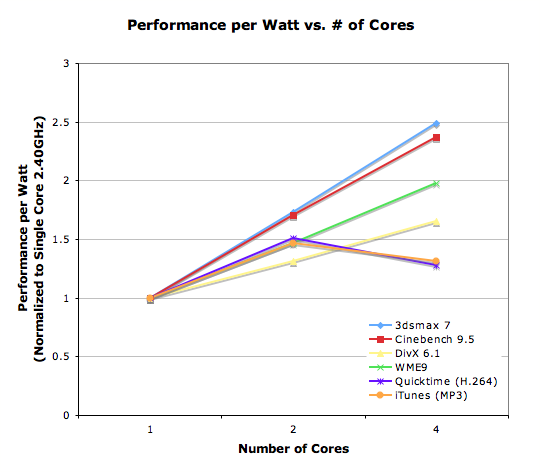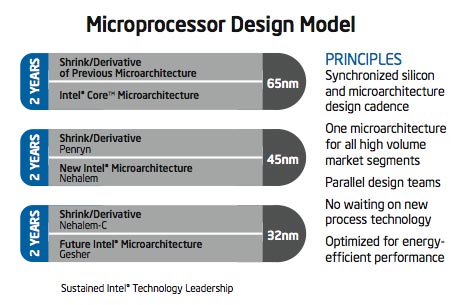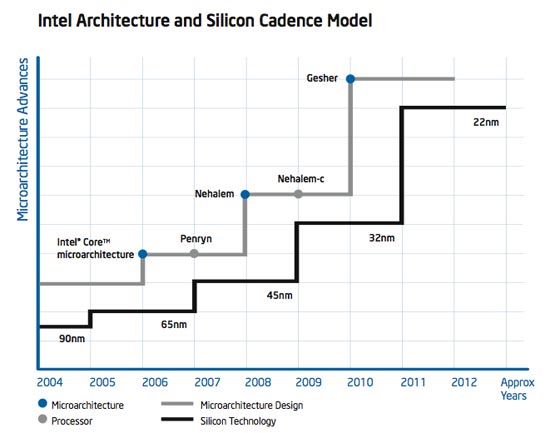Intel's Core 2 Extreme QX6700: The Multi-core Era Begins
by Anand Lal Shimpi on November 2, 2006 2:14 AM EST- Posted in
- CPUs
Analyzing Efficiency Trends
The graph below summarizes the data pretty well; what you're looking at is a graph of normalized performance per watt in six applications as a function of the number of cores in a Core micro-architecture CPU:

The graph illustrates exactly what we've confirmed here today: having more cores does increase efficiency if the software is designed to take advantage of those additional cores.
We have not yet hit the point of diminishing returns with adding more cores, but the two downward trending curves show the current problem with scaling from two to four cores. Very few desktop applications can take good advantage of a dual core CPU and even fewer are geared for quad core chips, and in those applications these quad core processors are actually a step back in terms of efficiency; it's not a fault of the processor, but rather of the software.
Through the benchmarks on the previous page we also highlighted another important point to take away: even in the areas where performance and efficiency were both improved, they came at a very expensive cost: twice the transistor count of Core 2 Duo. As much as Intel may call the next decade the era of multi-core and thread level parallelism, we simply can't lose focus on improving instruction level parallelism and core level efficiency.

Thankfully Intel has recently announced that it will be updating its micro-architecture every two years in an attempt to avoid problems like what happened with NetBurst and the Pentium 4. If it weren't for this change in microprocessor design model, the quest for more cores would end up no differently than the gigahertz race.

If all goes according to plan, it looks like we will get one of those improvements to ILP and core efficiency by the end of 2007/beginning of 2008 with Nehalem in order to avoid hitting another efficiency brick wall.










59 Comments
View All Comments
archcommus - Thursday, November 2, 2006 - link
Quote form the conclusion page:"We don't expect dual or quad core to be necessary for gaming anytime in the next 9 months..."
Really? That is surprising to hear. 9 months takes us to next July. I thought Alan Wake would definitely be released before then, and I thought that game REQUIRED two cores and would greatly benefit from four. Are you sure that statement isn't supposed to read "We don't expect QUAD CORE to be necessary for gaming anytime in the next 9 months..."?
JarredWalton - Thursday, November 2, 2006 - link
I thought Alan Wake was looking more like late 2007 (along with Unreal Tournament 2007 and some other games). We'll have an article looking into this area a bit more soon, but right now the games aren't out; they're in development, but the "when it's done" attitude often leads to launch dates that get pushed back.floffe - Thursday, November 2, 2006 - link
One game isn't gaming in general ;)johnsonx - Thursday, November 2, 2006 - link
AT Writers:The first chart on page 1 seems to have a typo. It states the Core 2 Quad has a die size of 162mm^2x2. But it shows the Core 2 die size as 143mm^2. If the Quad is just two Core2 dies, then why are they so much bigger?
The quoted die size of the Pentium D 900 at 162mm^2 suggests the source of the typo.
coldpower27 - Thursday, November 2, 2006 - link
As well if were going to be consistent and and call Core 2 Quad as 2x 143mm2 which is the right figure I might add not 2x 162mm2, then the Pentium D 900's should indeed be 2x81mm2 and not 162mm2 as it is stated right now on the chart.coldpower27 - Thursday, November 2, 2006 - link
Continued.. The reason being as the Pentium D is also 2 die on a single package just like Kentsfield as in this case you had 1 core on each die instead of a 2 core per die arragement.Sunrise089 - Thursday, November 2, 2006 - link
All I really needed to know from this article:1) Responsiveness isn't any better from CoreQuad
2) No mainstream software that I might use will take advantage of 4 cores in the near-future.
4) Quad-core does come at a large price increase (it isn't a free-lunch like the first dual-core chips from Intel were)
5) Quad-core doesn't overclock as well.
Decision - almost everyone who buys this at these prices is making a mistake, by the time the software catches up with this everyone will be ready to upgrade again.
eoniverse - Thursday, November 2, 2006 - link
From a gaming perspective definately. But if you render I like the performance increase. Price does suck. However when AMD 'replies' middle of 07 - the prices will adjust.And I'll be buying 'something'.
rowcroft - Thursday, November 2, 2006 - link
Do you think that with four cores, there are other bottlenecks limiting performance? I would think that moving to a striped disk array would be representative of a system that has a $999 processor.With four cores I would imagine there is some disk access contention happening. Especially since the iTunes test using write/reads pretty heavily doesn't it?
I'm no expert, just my thoughts.
EnzoM3 - Thursday, November 2, 2006 - link
Not a fan of one giant strip array. IMO, if disk contention is a problem, isolate the tasks that are contenting for disk access, then put the data on seperate physical drives. I put iTunes on one drive, page file on another, system files on main drive, videos and edits on another, and finally all iso's on one. Disk contention is never an issue even though rest of my system could use upgrades.